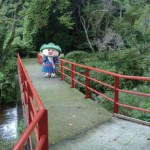Nebukawa (Kataura Coast) is located on the outer rim of the Hakone Volcano. During the Taisho Kanto Earthquake of 1923, landslides of the slopes in back of Nebukawa Station and avalanche of debris on the Shiraito River that flows south of the station occurred.
You can see the condition of the damage at that time by the memorial tower on the side of the station building and the Shakado (Buddhist temple).
On the ridges of the Nebukawa area, there are the remains of earthwork from the period of the Warring States called “Ujinao no kamae (Structure of Ujinao)”. During the Edo Period, it was managed as a mountain fortress of the Nebukawa check point. In this manner, the area around Nebukawa was a stronghold by taking advantage of the Hakone Volcano terrain. Along the coast, a stone quarry was opened for the stone wall of the Edo Castle. Remains of Yaana (holes to insert wedges) made when cutting out andesite can even be seen now.

Shakado (Buddhist Temple)
The Shakado was on a hill before the Taisho Kanto Earthquake.
It was buried under earth and sand by the earthquake however, after the earthquake it was dug up undamaged from the debris.
Faith in the undamaged and unscathed Shakazo (Buddhist Statue) grew. The Shakado was rebuilt and in an underground cave and you can see it as it was in the old days.
Battlefield of Ishibashiyama
In the year 1180 of the Heian Period, Minamoto no Yoritomo raised an army after receiving a request to overthrow Heike (Taira clan). On the way to Kamakura is the “Battlefield of Ishibashiyama” that was the stage of a hard fought battle. Yoritomo lost against the enemy army with more than 10 times the number of troops. After fleeing to Hakone Mountains, he went from Manazuru to Awa (Chiba Prefecture).
Nebukawa checkpoint ruins
In the beginning of the Edo Period, the Nebukawa checkpoint was a fortress that took advantage of the terrain and secured passage going through. The number of resident officials was second to the Hakone Checkpoint.
Nebukawa village drawing (Odawara City Library collection)
Nebukawa Stone
Nebukawa Stone is stone that was quarried from the lava in the area around Nebukawa and Komekami of the Hakone somma. This lava developed into plate-shaped joints and is two pyroxene dacite lava (about 3 hundred thousand years ago). A notable characteristic is the slightly curved plate-shaped joints and has been prized for monuments and stone paving from ancient times. Nebukawa stone was also sung in the text of Ogai Mori’s poem, “Sara no Ki (Sara’s Tree)”.






